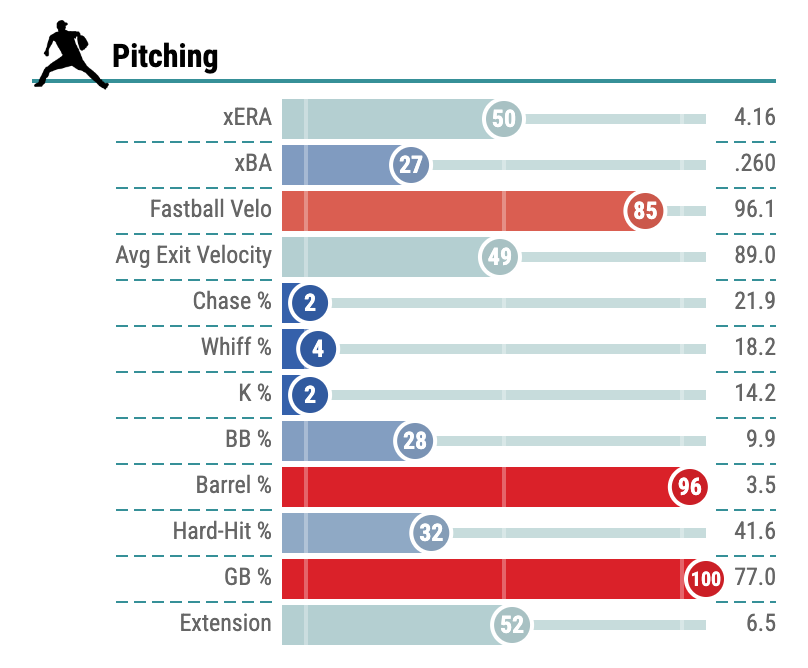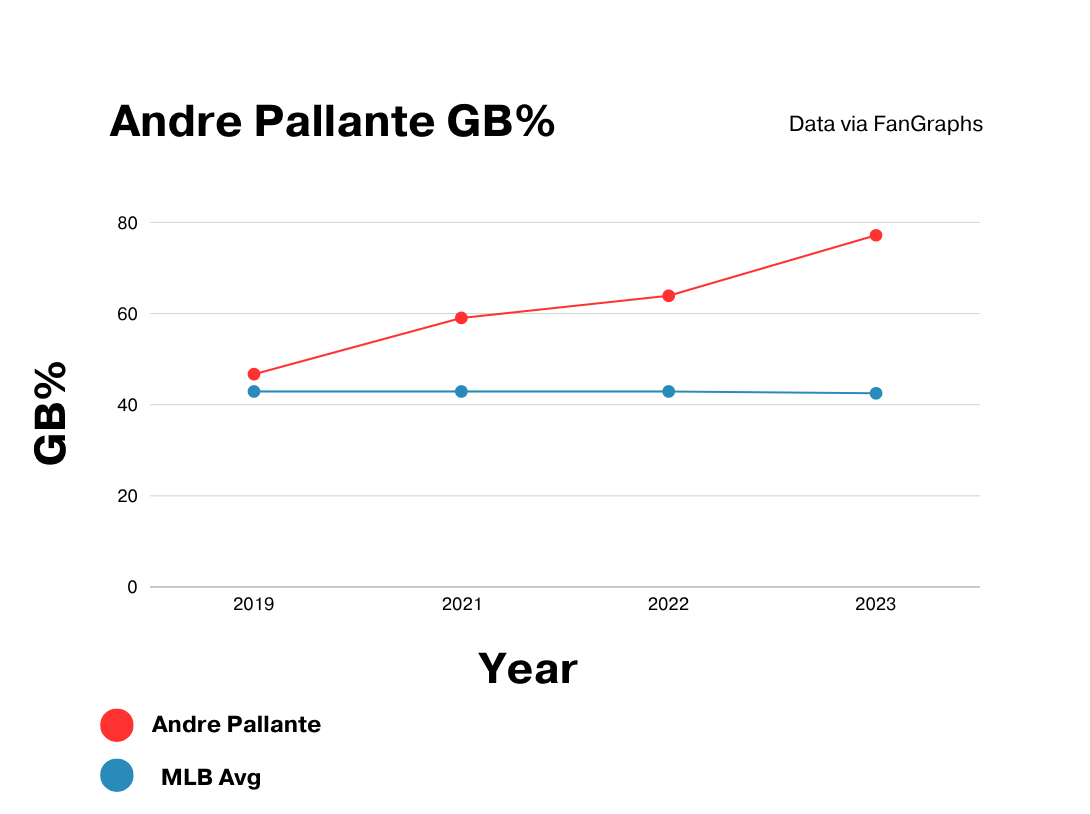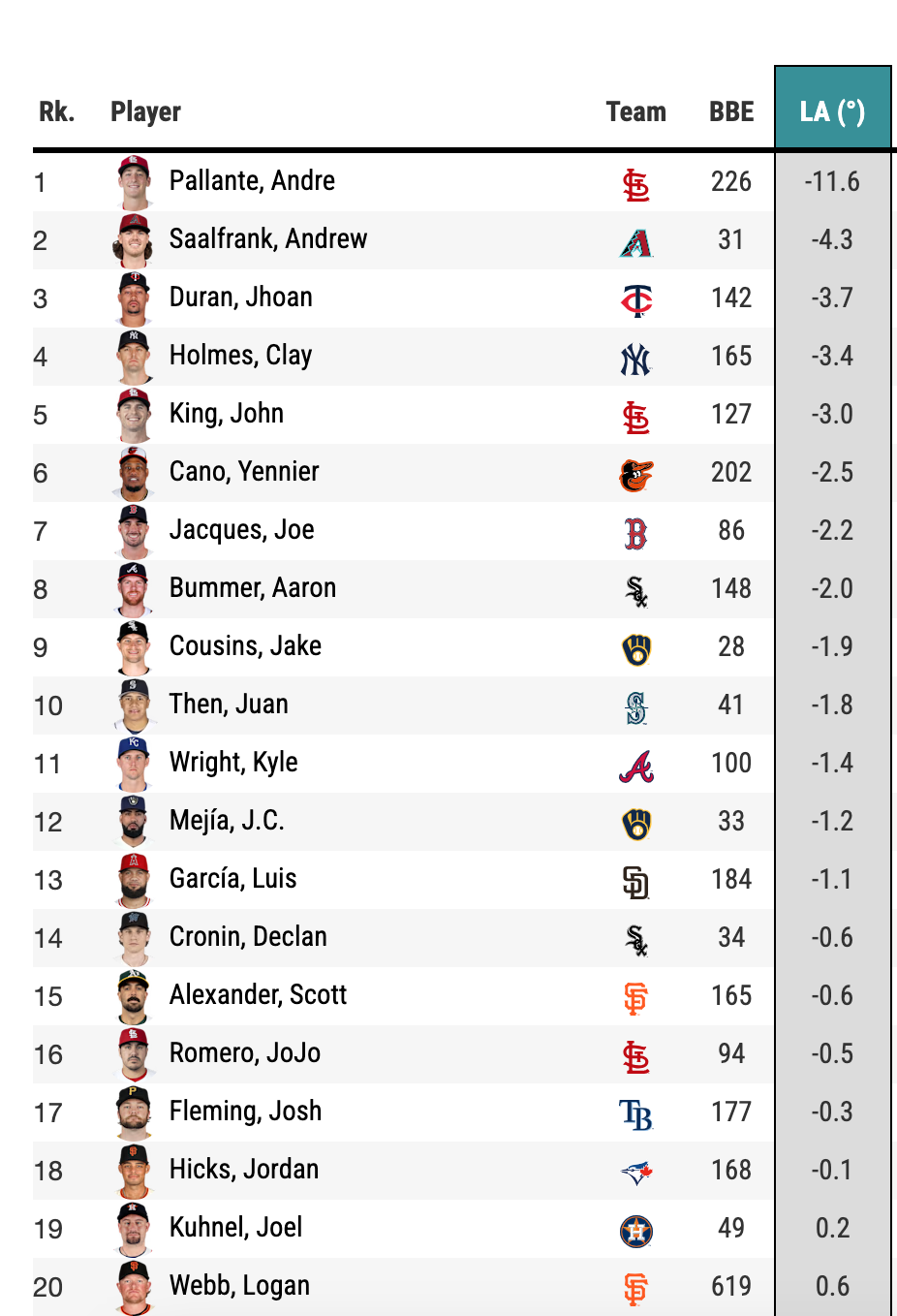This is not a typical Baseball Savant page.

It’s not a profile you see every day. Pitchers who average 96 mph on their fastball are supposed to miss bats, but this guy had one of the lowest strikeout rates in the league, barely ever getting batters to chase or generating swings and misses. It’s not as if he had great control – he posted a below-average walk rate – or excelled at inducing weak contact. But despite allowing a lot of contact, and hard contact at that, he had the league’s best ground ball percentage.
This anomalous pitcher, as you might have guessed based on the title of this article, is the wonderfully weird Andre Pallante in 2023.
Pallante has been a ground ball pitcher since the Cardinals drafted him out of UC Irvine in 2019, posting a 46.7% ground ball percentage in his first taste of the minors. Since then, Pallante’s extreme ground ball profile has only been accentuated, with his GB% rising every year he’s been in the professional ranks. In 2023, Pallante recorded a league-leading 77.8 GB% (min. 30 IP), over 10% higher than runner-up and Cardinals teammate John King. Since 2002, which is as far back as our records of GB% go, Pallante’s 2023 was the third-highest GB% season of all time, only behind Zack Britton’s 2015 and 2016 (in which he had 79.1% and 80.0% marks respectively). Essentially, if you made contact against Pallante last season, there was a better than three-quarters chance that you would have hit the ball on the ground.

** Note: Pallante’s GB% figures shown are from both MLB and MiLB
It’s not just the high ground ball percentage that makes Pallante unusual, but the sheer number of ground balls put into play against him. Unlike Britton – an accomplished strikeout artist during his day – Pallante has a K% that would look more at home in the 1980s than it does compared to his 2020s contemporaries. Despite walking batters more than is ideal (more on that in a bit), that lack of strikeouts means that Pallante is allowing a whole lot of contact, meaning a whole lot of ground balls. Just how many exactly?
I looked at all pitchers with at least 30 IP in a season since 2002 and calculated what percentage of plate appearances they pitched that ended in a ground ball; this differs from standard GB%, which is just the percentage of ground balls out in play while my new metric accounts for events like Ks, BBs, and HBPs. We can call this new metric GB/PA%. In 2023, Pallante had a GB/PA% of 46.42%. That’s an exceptionally high rate. In fact, it’s even higher than the regular GB% for any year from 2002 on. It’s the third highest GB/PA% ever recorded as far as we can track, behind only Brad Ziegler – another low strikeout, ground ball-inducing luminary – in 2012 and 2015, the latter of which saw him set the all-time GB/PA% record with a ridiculous 48.53% mark. You can take a look at the all-time GB/PA% leaderboard here.
I’d argue that Pallante’s 2023 was an even more impressive ground ball season than anything Ziegler ever did because of the era in which it occurred. Since 2015, when Ziegler set the record, strikeouts and walks have only been more commonplace, as we’ve seen pitchers increase their pitch velocity and develop increasingly nasty stuff without necessarily having a better feel of how to locate it. Ground balls too have dropped in frequency, largely thanks to the fly-ball revolution of the mid to late 2010s that has encouraged hitters to add loft to their swings and hit the ball in the air in hopes of extra bases. Take a look at the trajectory of league-wide GB/PA% from 2015 to 2023.
| Year | League GB/PA% |
| 2015 | 25.50% |
| 2016 | 24.72% |
| 2017 | 24.13% |
| 2018 | 23.48% |
| 2019 | 23.00% |
| 2020 | 22.71% |
| 2021 | 22.99% |
| 2022 | 23.45% |
| 2023 | 22.93% |
GB/PA% is down league-wide to such an extent that after Pallante, the best GB/PA% recorded by a pitcher in the 2020s was actually King in 2023, who only ranks 30th overall. I’m not sure exactly how to add an era-adjustment component to GB/PA%, but I am more than certain that Pallante would rank No. 1 if I did. He’s blowing his contemporaries out of the water.
But though Pallante has demonstrated that he is historically elite at getting batters to hit grounders, it’s still an open question if he is all that good. Ground balls are, in general, a positive outcome for a pitcher. While plenty of ground balls turn into hits, the vast majority of them don’t become extra-base hits, and they never turn into home runs. Because home runs are the most valuable outcome for a batter, preventing them as a pitcher is really good, making higher ground ball rates desirable. Take Pallante for example. Out of the fly balls he allowed in 2023, 26.1% of them went for home runs. That’s a really high percentage – much of which can be attributed to unlucky variance and, in this case, a small sample size – but because so much of the contact Pallante allowed was on the ground, he still allowed just six homers in 68 IP. His HR/9 was only 0.79, solidly above league average even with bad HR/FB luck. If that percentage normalizes for Pallante in 2024, which in all likelihood it will, he should allow even fewer homers. That’s a strong foundation to work with.
Pallante’s bread-and-butter pitch is his four-seam fastball, and he leans on it heavily. In 2023, he threw it 66.3% of the time, a rate that ranked 10th among pitchers who reached the 30-inning threshold. Pallante throws it hard, averaging 96.1 ticks, but, as previously stated, he does not get swings and misses out of it. That’s because of the unusual movement profile of the pitch, which has very little break to it. It creates the effect of a pitch coming in oddly flat and straight. FanGraphs’ Eric Longenhagen has described it as “like a tennis serve.”

** iHB = Horizontal Movement, iVB = Vertical Movement
Whatever he’s doing with his four-seamer, hitters can’t help but hit it on the ground. In 2023, batters averaged a -17 degree launch angle against the pitch, a hilariously low number. It led to a cartoonish 85.9% GB% on contact; an absolutely minuscule 3.5% of balls in play versus the pitch were fly balls. At PitcherList we have a stat called Ideal Contact Rate (ICR), which looks at how often a hitter made optimal versus suboptimal contact on a given pitch; a low ICR is good for a pitcher. Pallante had just a 24.2% ICR on his fastball last season, in the 96th percentile amongst relievers. In short, batters struggled to do anything other than hit grounders against the pitch.
Pallante’s arsenal also includes a slider and a curveball. Though not quite as extreme as his fastball, both pitches generate a lot of grounders, respectively having 50.0 and 63.2 GB% in 2023. Both pitches have considerably more vertical movement than his four-seamer, adding some diversity to his mix. The curve in particular also offers Pallante a real change of speeds, as it averaged a slow 76.9 mph last season. However, batters had far more success against these secondary offerings, slugging slightly over .600 on both pitches over the 2023 season. Though Pallante’s xSLG numbers seem to indicate that he was a touch unlucky, most of his success is concentrated in the four-seamer.
While he might not have a ton of weapons beyond his heater, the whole package helps contribute to the extreme ground ball profile. Though the -17 degree launch angle against his fastball was by far the most dramatic on any of his pitches, the launch angle for his overall arsenal was still an outlier at -11.6. For context, of 687 pitchers who had at least 25 batted ball events, only 18 of them had launch angles in the negatives at all. Pallante’s clocked in at the lowest. Number two, the Diamondbacks’ Andrew Saalfrank, had a mere -4.6 degrees. There is a chasm between Pallante and everybody else.

Where Pallante struggled most last year came down to batted ball luck and too many walks. When you’re striking out as few batters as Pallante does, that means that you’re leaving a lot up to the whims of the batted ball gods. On a Cardinals team that was below average defensively last season, that wasn’t to his benefit; while the .318 BABIP batters had against him wasn’t terrible, it was worse than league average. When there are already batters on base because of walks, those balls that roll through for singles become more likely to be knocking in a run than they would be otherwise. For Pallante to take a real step as a pitcher, he’ll have to cut back on the free passes to limit baserunners, and maybe even trade in some ground balls for strikeouts to avoid flukey hits.
Reports out of spring training are that Pallante has made some adjustments this spring, namely introducing a sinking fastball as a weapon to attack righties, whom he struggled against last season. The sinker is another pitch geared toward generating ground balls, but the hope is also that it will help Pallante record a few more Ks than he has in the past. A 26.8 K% and 4.9 BB% in spring training reflect this improvement, though 10 innings of spring training statistics notoriously are not worth drawing sweeping conclusions from. We’ll have to see if Pallante actually carries these adjustments with him into the season.
Is Andre Pallante one of the best pitchers in baseball? Or even in the Cardinals bullpen? Probably not. But he sure is fun. Diversity is what makes baseball such a delightful sport to watch, and no one pitches quite like Pallante. The Cardinals may have seen one legend known as “The Machine” retire, but, while perhaps not quite as electrifying, now they have “The Ground Ball Machine” to keep us entertained. I, for one, can’t wait to follow along as he tries to top his own GB/PA% record in 2024.
